For a more detailed explanation, see the usage in the textbook (pages iii - v)

- 1. Cover page
- (lesson topic, title, and grammar points)
- 2. Grammar page
- (comes before the text)
- 3. Vocabulary from Context
- (appears on the Center Test)
- 4. Pre-Reading
- (Communicative activities)
- 5. Text (Parts 1 - 4)
- (left-right layout)
- 6. Comprehension and Communication
- (wide variety - more in the teachers’ manual and student workbook - saves teachers preparation time)
- 7. Grammar Practice
- (drills)
- 8. The Writer’s Corner
- (a chance for students to see a different point of view)
- 9. Listening, Writing, Class discussion
- (more opportunities for communication)
- 10. (Optional)
Reading Techniques (pages 122 - 141)
↓
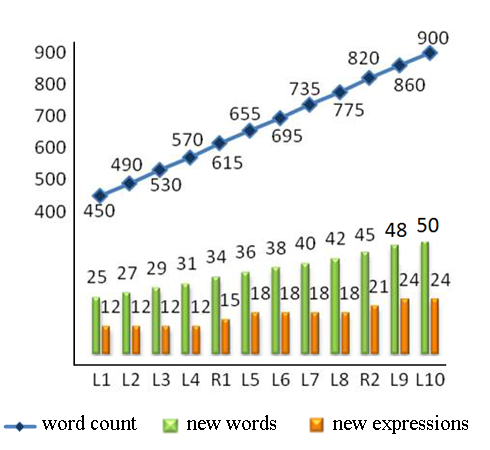
The amount of text and vocabulary in each lesson is strictly controlled.
The amount of text grows by 40 or 45 words from lesson to lesson. The amount of new vocabulary and expressions also increases little by little. Therefore, the students can take small steps towards improving their reading skills.
The amount of text doubles from lesson 1 to lesson 10, as does the amount of new vocabulary and expressions. These clear goals can act as motivators for students.
More highlights. For additional information, see the usage in the textbook (pages iii - v).
-
1. The grammar page comes before the text (before Parts 1 - 4).
By understanding the grammar points first, students will be able to handle the text more easily. Moreover, the grammar points are introduced through very simple and natural sentences. These sentences are often followed by more challenging sentences from the text that have the same grammar pattern. For example, in lesson 1, the first sentence structure (SV) is introduced like this:
I work. S V Technology progresses < very fast >. [p.6, l.1]The brackets around very fast show modifiers, which are also discussed. -
2. The order in which the grammar sentences appear in the text is controlled.
G-1 is introduced first, in part 1 of the text. Then, G-2 is introduced in part 2 (while more G-1 sentences are reviewed), and G-3 is introduced in part 3 (while more G-1 and G-2 sentences are reviewed). Part 4 of the text is used to further review G-1, G-2, and G-3. G-2 doesn’t appear in part 1, and G-3 doesn’t appear in part 2. This allows teachers to cover G-1 on the grammar page, then read part 1 of the text and so on. Moreover, the target grammar appears many times throughout the text, giving students lots of chances to become more familiar with each grammar point.
-
3. Each lesson has many opportunities for communication.
The vocabulary from context conversations, the pre-reading activities, the comprehension questions after each reading part, the grammar drills, the listening questions, and the writing/class discussion activities can be done/checked in pairs, groups, and as a class.
-
4. The lesson topics are stimulating and relevant to the lives of the students.
The topics give the students many opportunities to think about current issues regarding Japan and the world. Moreover, through the many pair work, group work, and class activities, the students can communicate with each other and express their opinions on these issues.
-
5. The text of every lesson has a very clear voice.
The students will enjoy reading the stories and will be able to handle them well, without much translation from the teacher.
-
6. There is very little Japanese used in this textbook.
The students can feel like they are in “an English world.”
| The Reading Techniques section uses a wide variety of question styles. These question styles appear in major English tests, such as the Center Test, TOEFL, EIKEN, IELTS, GTEC, and TEAP. The Reading Techniques section helps the students by giving hints for how to answer each kind of question. | ||
| Question style | Found in these tests | Used in these Reading Techniques (pages 122 - 141) |
| Comprehension | all tests | 1, 4, 5, 6, 7, 9, 10 |
| Vocabulary from context | TOEFL, Center Test | 1, 5, 6, 10 |
| Referents (e.g. What does 'it' refer to on line 4?) | TOEFL | 3, 5, 9 |
| Fill a gap in the text (transitions) (e.g. 'however', 'next') | EIKEN, TEAP, TOEIC | 3, 5, 6, 8, 10 |
| Which is true? | TOEFL, Center Test, IELTS, TEAP | 2, 5, 8 |
| Which is not true (or not in the text)? | TOEFL, Center Test, IELTS | 3, 4, 5 |
| True / false / question mark (not given) | IELTS | 2, 3, 8, 10 |
| Fill a gap with a rephrased sentence. | IELTS | 1, 4, 7 |
| Insert the sentence or phrase. | TOEFL | 1, 6, 8, 10 |
| Which paragraph contains the following information? | IELTS | 4, 9 |
| What's the best heading for each paragraph? | IELTS | 2, 5 |
| Insert a phrase/sentence from choices. | Center Test | 1, 5, 6, 8, 9 |
| Which sentence does not fit the paragraph? | Center Test | 2, 7, 9 |
| What is the passage about? / What is the main point? | Center Test, TOEFL | 2 |
| What might come next? | Center Test, TOEFL | 6, 7 |
| Putting together different pieces of information (from text, table, etc.) | Center Test, GTEC | 3 |
| Identify the correct image based on the text. | Center Test, IELTS, TOEFL | 4 |
| Complete a table based on the text. | Center Test, TOEFL | 3, 10 |
| Put images into the correct order. | Center Test | 8 |
Support Material for Teachers and Students
Teachers’ Manuals (予価16,000円)
- Book 1 = Lessons 1 - 5, Reading 1, Reading Techniques 1 - 5
- Book 2 = Lessons 6 - 10, Reading 2, Reading Techniques 6 - 10
- Answer keys for every exercise in the textbook / list of CD tracks
- Student-focused English lesson plans - involve the students in the class from the beginning to the end and teach effectively in English (can be used by ALTs)
- Grammar and exercise explanation (as explained by veteran Japanese teachers of English - very useful, especially for younger teachers)
- Additional points of interest related to each lesson topic
- Sample writing for writing exercises
DVD-ROM (MS Word files)(for all lessons and activities)
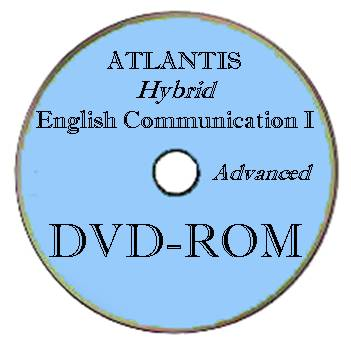
- Tests and quizzes (for every lesson)
- Vocabulary lists / tests
- Listening scripts for printing
- Japanese translation of the text
- Pictures related to the lesson topic
- Links to related videos online
Full class CDs (including pronunciation) (予価14,000円)
Communication I Advanced - Sample CD Tracks
- Lesson 1, Part 1 New Words
- Lesson 1, Part 1 New Words in Context
- Lesson 1, Part 1 Expressions
- Lesson 1, Part 1 Expressions in Context
- Lesson 1, Part 1 Slower
- Lesson 1, Part 1 Normal Speed
- double
- [a] microchip
- a translator
- subtitles
- double
- I want to double my salary.
- [a] microchip
- Computers have many microchips.
- [a] translator
- I’m good at English. / I want to be a translator.
- subtitles
- Can you watch American movies / without subtitles?
- every (two years)
- smaller and smaller
- What does ~ mean?
- in the near future
- will be able to
- walk down the street
- every (two years)
- I go to America / every two years.
- Technology doubles / every two years.
- smaller and smaller
- Microchips get smaller and smaller.
- What does ~ mean?
- What does this mean?
- in the near future
- will be able to
- In the near future, / we will be able to / travel to other planets.
- walk down the street
- When I walk down the street, / I look at people’s faces.
What will the future look like? Technology progresses very fast. Computer power and speed double every two years, and computer microchips get smaller and smaller. What does this mean for us?
In the near future, people will have Internet eyeglasses and contact lenses. These glasses and lenses will be able to check websites, download music, and know people’s faces. As we walk down the street, the glasses and lenses will tell us many things about the people around us. For example, we can know their names, birthdays, and favorite songs. When we travel to other countries, our Internet glasses and lenses will be our translator and tour guide. They will understand foreign languages and give us subtitles. They will recognize famous places and tell us interesting things about them.
What will the future look like? Technology progresses very fast. Computer power and speed double every two years, and computer microchips get smaller and smaller. What does this mean for us?
In the near future, people will have Internet eyeglasses and contact lenses. These glasses and lenses will be able to check websites, download music, and know people’s faces. As we walk down the street, the glasses and lenses will tell us many things about the people around us. For example, we can know their names, birthdays, and favorite songs. When we travel to other countries, our Internet glasses and lenses will be our translator and tour guide. They will understand foreign languages and give us subtitles. They will recognize famous places and tell us interesting things about them.
Student CD
Student Workbooks (B5)
Additional comprehension questions, summarizing the text, grammar drills, vocabulary exercises, word stress exercises, etc.

ATLANTIS Hybrid English Communication II Advanced was submitted to the Ministry of Education in February, 2016. ATLANTIS Hybrid English Communication III Advanced will be submitted to the Ministry of Education in early, 2017.
Although the Ministry of Education does not allow us to talk about English Communication II or III (as these textbooks have not yet been approved), we can tell you that it is our full intention to deliver a three year plan. All three books (I, II, III) follow similar principles.
Related textbooks for 2017
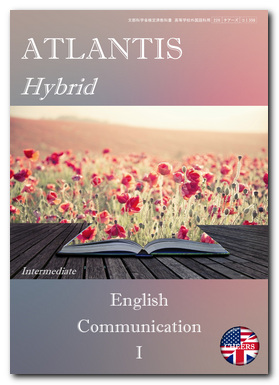 Communication I Intermediate
226 チアーズ
Communication I Intermediate
226 チアーズ
コⅠ358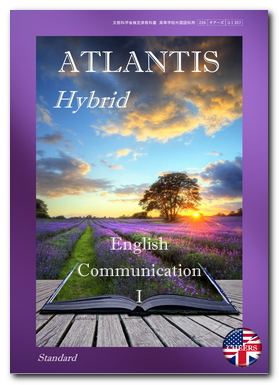 Communication I Standard
226 チアーズ
Communication I Standard
226 チアーズ
コⅠ357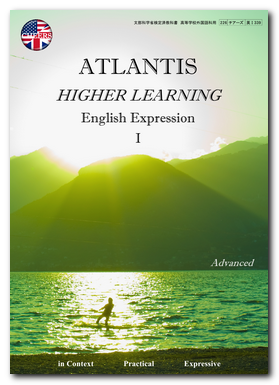 Expression I Advanced
226 チアーズ
Expression I Advanced
226 チアーズ
英Ⅰ339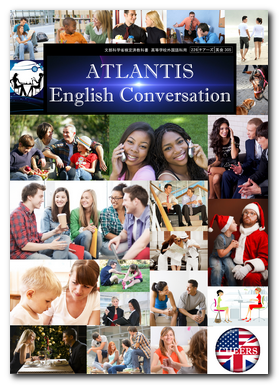 Conversation
226 チアーズ
Conversation
226 チアーズ
英会305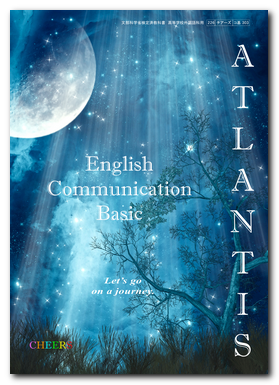 Communication Basic
226 チアーズ
Communication Basic
226 チアーズ
コ基303